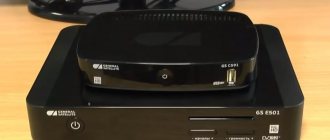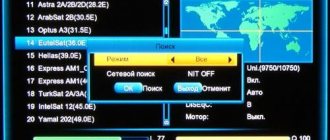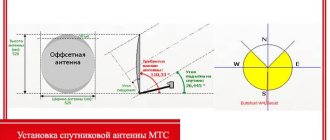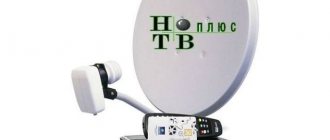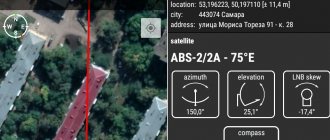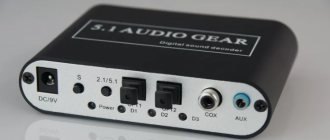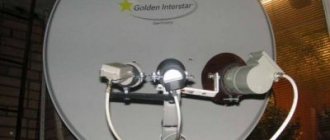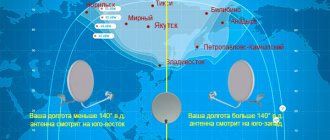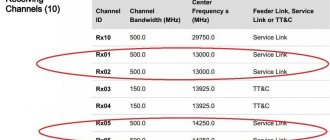Correct setting of the satellite dish has a key impact on the quality of satellite signal reception. Many people are afraid to install a satellite dish themselves, but after reading this guide, this procedure will no longer seem so difficult.
Let's figure out how to position the satellite dish and connect it yourself.
Materials and tools needed to install a satellite dish
You will need:
- Satellite dish with signal converter.
- Antenna mast or wall bracket (sold separately), depending on technical capabilities and installation location.
- External antenna cable designed for satellite installation (with a resistance of 75 Ohms). To assemble a Full HD set-top box with a recording device, you will need two cables. If you install a multiroom system, a correspondingly longer coaxial cable will be required.
- Type "F" connectors corresponding to the diameter of the coaxial cable, keys and tools necessary to attach the mast.
- Compass, protractor, ruler or corresponding application on your smartphone.
- Cable ties or glue, electrical tape, dowels, connectors for lightning protection . If it is not possible to make a hole in a window or wall for laying the cable, use a special flat cable with “F” type connectors.
Set of equipment for satellite TV
Instruments and equipment for installing and connecting a satellite MTS antenna
Note! When choosing equipment, it is important to consider the region of residence and the characteristics of the TV.
Antenna
When choosing an antenna, pay attention to the diameter. For most regions, the optimal diameter of a satellite dish is 0.6 meters. Antennas with a diameter of 0.9 meters are recommended to be installed in regions with weaker signals, for example, in the Kaliningrad region, Primorsky Territory, the Republic of Sakha, Yakutia and Karelia.
You can also keep the antenna from your previous provider. When setting it up, it is enough to redirect it to another satellite and change the converter to a linear one.
Converter
The converter is mounted on the antenna. Responsible for receiving the signal, its further conversion, and transmission via cable to TV. The number of inputs on the converter must correspond to the number of connected TVs. The device is included in the standard equipment package from MTS.
Cam module or set-top box
Here we pay attention to the characteristics of the existing TV. The kit with a cam module is suitable for TVs that have a built-in DVB-S2 receiver and support the HEVC format. For other TVs, we purchase a set-top box from MTS. The number of cam modules or set-top boxes must correspond to the number of TVs.
You will also need a bracket, a coaxial cable for connection, a 2 °F connector and other little things. All this is included in the branded basic installation equipment package.
MTS installation equipment kit
Installing a satellite dish and laying cables
In stores that sell equipment for satellite TV and satellite dishes, you can buy various types of antenna holders that are attached with brackets to the wall or antenna mast.
- Select the bracket that suits your installation location.
- Attach it as firmly as possible to a rigid base.
Installing a satellite dish using brackets - Buy a quality cable of suitable length. It is best to take a section with a margin of at least 3 meters (a cable longer than 30 meters requires a signal amplifier), which will connect the antenna kit to the HD decoder.
Satellite cable - Route and secure the cable so that there is no risk of tripping over it or accidentally damaging it (avoid sharp bends).
- Cut the cable after installing it. .
- If the converter is equipped with a water guard, place it over the cable before inserting (draw-out converters do not require a guard).
- F-type connectors should be screwed tightly to the coaxial cable, using wire cutters if necessary (it is better to use a special wrench). It is important to carefully prepare the cable and ensure that the metal braid of the coaxial cable does not touch the center wire.
Important: in houses equipped with a lightning protection system, the mast must be connected to it with a copper cable with a cross-section of 50 mm² or 80 mm², and external wires must be connected to the mast with a cable with a cross-section of 40 mm². But these requirements are not mandatory if the antenna is located less than 2 meters above the roof and closer than 1.5 meters to the wall from the house, that is, on the balcony.
Choosing the right place to install a satellite dish is the first task
Installation instructions: choosing a location, calculating elevation angle, azimuth
Russian satellite TV operators are divided into two categories - southern (which includes NTV-plus and Tricolor TV) and eastern (Telekarta, MTS). In this case, we will give an example of installing a south antenna.
Read more about setting up a satellite signal from MTS in our material.
Map of satellites - you can start from it when setting up the satellite dish for the first time
Correct installation of a satellite dish depends on the correct setting of four parameters:
- azimuth is the angle between north and the desired direction;
- angle of inclination/elevation – angle of orientation of the plate in the vertical plane;
- elevation angle – a horizontal angle corresponding to the rotation of the plate left-right;
- converter rotation - the angle at which the antenna looks in a given direction of the world.
Adjusting the Azimuth Angle Using a Compass
Azimuth for different cities
Tilt adjustment:
If the converter has a scale or you have a protractor, turn the converter to the value in the table above that corresponds to your city.
The azimuth is set with a compass and measured in a clockwise direction. The antenna direction angle (azimuth – 180º) is measured from the south clockwise.
- use mounting bolts to secure the converter in the bracket;
- attach the antenna to the mast and adjust the angle;
- screw the wires to the converter and to the receiver;
- Connect the set-top box to the TV according to the instructions and launch it.
Installation, connection and self-tuning of a satellite dish - video instructions:
You can fine-tune the position of the satellite dish based on the measurement results of the received signal. You don't need a special counter for this. Modern decoders have sufficient functionality to measure the signal received from the satellite.
Calculation of elevation and azimuth when installing a satellite dish
How to choose satellite TV in the Russian Federation - the best operators for 2021
The list of various providers today is very large. Any viewer can choose the desired option without much difficulty.
Tricolor TV
"Tricolor TV" (official website of the provider https://www.tricolor.tv/) is one of the most popular providers in the Russian Federation. The company has been operating for many years. The price for their services remains very affordable, and the choice of services provided is the widest.
Advantages:
- For 2000 rubles you can get a fairly wide package of services;
- it is possible to connect on two devices simultaneously;
- Availability of installment plans for new equipment upon delivery of old equipment.
Flaws:
- The company releases updates too often, without installation of which the image quality begins to rapidly decline.
- The packages are missing many world-famous channels, the absence of which has a significant impact on consumers.
Satellite signal coverage from Tricolor TV
Satellite TV MTS
MTS-TV (official website https://sputnik.mts.ru) is a relatively new provider, but no less popular. The reason for this popularity is that the service offers not only a subscription to many channels, but also a fairly wide media library. It gained particular popularity in the Trans-Ural region.
Advantages:
- Availability of cashback upon installation.
- Connection to the Internet and television at a single tariff.
Flaws:
- Not the lowest prices for services.
- There are no additional packages to install.
Satellite signal coverage from MTS TV depending on the radius of the dish
NTV-plus
NTV-plus (website https://ntvplus.ru) is currently the oldest satellite TV network in Russia. Compared to other providers, prices for their services may differ significantly.
So the cost of a standard package of services is about 1,500 rubles. For this price you will get 190 channels at your disposal. This is quite enough to have a great time in your free time.
Advantages:
- A wide selection of all kinds of tariffs to suit every taste.
- Dividing channels into different subgroups, making it easier to navigate within the menu.
- Installment plan without paying extra interest when purchasing equipment.
Flaws:
- Uncertainty when paying tariffs.
- High prices for additional services.
Satellite signal coverage from NTV-plus
Signal setup
Signal quality is critical. When positioning the antenna, you should be guided by the maximum value of the quality parameter, even at the cost of reducing the signal power. If you find an antenna position with maximum signal strength and zero quality, it means the antenna is pointing at another satellite.
In this case, you should continue your search, first of all by changing the direction of the antenna. Once you have found the satellite you want, adjust the LNB settings to get the best quality.
Setting up a satellite dish:
- After connecting the device, a start screen will appear on the TV screen indicating the signal levels (if not, you can open it by pressing F1 on the keyboard or I on the remote control). Typically these are two parameters: signal strength/power and quality (these parameters are also displayed on the displays of some set-top boxes).
Signal quality - The force parameter must have a value greater than zero. For example, this could be 50%, depending on the type of converter and the length of the antenna cable, which confirms the correct connection. The quality parameter for the first time will most likely be at zero, because “hitting” the satellite in the initial settings is unlikely.
- To fine-tune the signal, you need to manually rotate the antenna 2-3 degrees in the horizontal plane, monitoring the signal level, and then move the converter closer and further away from the antenna, observing the signal quality indicator. After this, you need to tighten the screws securing the antenna to the mast (they need to be screwed in one by one, controlling the signal parameters so that deformations of the antenna fasteners do not change its position). The antennas are attached to the mast with two screws, and after tightening them, additional adjustments to the angle of inclination may be required
- The process may take some time, so it is better to have two people do this - one turns, the other watches the signal level change. The optimal signal level for normal video playback is from 70%. After this, start an automatic search for TV channels and save the settings. Even if the antenna becomes damaged, you will not need to repeat the procedure again.
An important point: in the factory state, many decoders automatically activate the download procedure after startup. If there is no signal reception from the satellite, the first startup process will stop on the settings screen with the signal measurement results, or it will be preceded by the antenna installation selection screen. If the decoder has already been launched previously (for example, at the seller's office to check its functionality), the startup procedure will stop at the screen already mentioned above with the strength and quality parameters.
Principle of operation
Satellite works just like terrestrial television. The dish is used as a receiving device, and the satellite serves as a repeater. Therefore, for successful operation it is necessary to receive a high-quality signal and display the image on the screen.
Television broadcasts in analog format and digital standard. In the latter case, a digital signal of the DVB-S/S2 standard is transmitted, which must be decrypted before viewing. Only two devices can be used for this:
- TV tuner. A built-in TV decoder of digital information into a familiar image.
- Receiver. A separate device for decoding the digital signal and displaying the image on the screen.
Television supply
There are two types of programs broadcast from the satellite - open and encrypted TV channels. The latter are paid content, to unlock which you use an operator payment card inserted into the CAM connector.
From what has been discussed, we can conclude that in order to connect a satellite dish, you need two devices - a decoder and a CAM connector.
Technically, television is available even if you connect a dish without the above-mentioned equipment. However, only open channels will become available, and the image quality will remain at a low level, comparable to ATV. Therefore, to watch high-quality television, you need to connect both devices.
Software and programs for PCs and smartphones for setting up satellite television
Satellite Antenna Alignment
Using this free PC program, you can easily and easily calculate the azimuth and elevation angle for installing a satellite dish. The program is very easy to work with.
After launching the program, simply enter the latitude and longitude of your home in the “Coordinates of the antenna installation” section (you can find out by opening Google maps and entering your address). The left side of the screen will display the azimuth angles and locations for all possible satellites. Find the satellite you need and use the obtained coordinates. The program can be downloaded completely free of charge here: https://satellite-antenna-alignment.ru.uptodown.com/windows.
Advantages:
- many settings;
- completely Russian-language;
- works in all parts of the world.
Disadvantages: outdated interface.
SatFinder
A similar free smartphone app is called SatFinder. It allows you to configure a satellite dish using GPS navigation and operates in two modes:
- In camera mode.
- In "sight" mode.
In the first case, the location of the satellites is automatically displayed on the phone screen in the form of a special arc. All you need to do is point the antenna correctly.
In aim mode, the app will guide you using coordinates and arrows that will change as you move the antenna. If it is aimed exactly at the satellite, the arrows in the application will turn green. The application can be installed for free from the Google Play store https://play.google.com/store/apps/details?id=com.esys.satfinder&hl=ru&gl=US.
SatFinder program interface
Advantages:
- two satellite search modes;
- instant location determination via GPS;
- convenient interface.
Disadvantages: none found.
Dishpointer Pro
A good alternative application for a smartphone. It's not free, but it's considered one of the best satellite dish tuning apps in the world. It can be purchased for Android from the Google Play store https://play.google.com/store/apps/details?id=satellite.finder.comptech&hl=ru&gl=US.
Advantages:
- high-precision satellite identification;
- finding the user even in conditions with a poor GPS signal (using mobile operator data).
Flaws:
- the application is paid;
- menu in English.
How to set a satellite dish to 75 degrees
Let's consider, as an example, the process of setting up a dish on the ABS 75E satellite.
Initially we need to determine the azimuth (antenna direction):
- Open Yandex maps, enter the name of the locality in which the installation is taking place. We take the coordinates from there and copy them.
- Turn on the receiver and enter the coordinates in the “Satellite Guide” tab and click “Calculate”
- Now we know the azimuth and tilt angle of the antenna. We determine the direction using a compass and fix the plate on the bracket.
Now you need to configure the signal:
- We turn on the tuner and in the “Installation” section we find the ABS 75E satellite.
- We return to the antenna and begin to slowly move it up and down until we catch the signal from the ABS 75E. Then we scan the channels.
Installing and configuring satellite antennas on ABS 75E, the language is not Russian, but everything is intuitive:
Once the signal is picked up and the channels are located, you can fasten all the screws and connect the dish to the tuner.
Technical description
Satellite television is a broadcast signal that is transmitted to viewers’ screens using a complex of satellites that orbit the Earth.
Due to the fact that the need for telecommunications is increasing every year, terrestrial broadcasters have ceased to fully cope with their functions.
They are not capable of supporting signal transmission over long distances, and one could completely forget about relaying overseas. An equally important disadvantage of older formats is the instability of image and sound quality. Thus, devices located at a relatively close distance to the source receive the information flow better, as a result of which the level of picture and audio varies greatly. Satellite TV is a great alternative to more outdated broadcast technologies. This way the quality of broadcasting is maintained at a high level.
The main advantage is low energy consumption. So the satellite rotates in orbit following the planet without wasting extra resources, and the power source is solar panels, the power of which is completely sufficient to maintain the operation of space equipment.
The coverage of the territory is quite large; the signal can easily cover up to a quarter of the surface of the entire planet.
Broadcasting can be done in two different ways:
- Direct television broadcasting is the simplest and most accessible. This way the video signal goes directly to the viewer, eliminating intermediaries.
- Retransmission using terrestrial television centers - first the information reaches one specific point, after which it spreads further with the help of antennas until it reaches the consumer.
Coverage of the territory of the Russian Federation with an MTS satellite signal.
The type of broadcasting depends on the operator you initially chose. If you are not satisfied with any of the above options, then you can safely refuse the services of this provider and switch to the type of broadcast that will be convenient for you personally.
Setting up a satellite dish for 3 satellites Amos, Astra, Sirius Hotbird
Installing satellite television from three satellites will allow you to watch many free Russian-language TV channels (more than 90) and a huge number of foreign ones (more than 2 thousand). Standard equipment:
- satellite antenna,
- three Ku-band converters;
- two plastic fastenings for side converters;
- antenna masts or brackets;
- DiSEqС (Disek) - converter switch;
- F-type connectors;
- coaxial cables 75 Ohm.
Astra
Transponders for satellites Astra, Amos, Hot Bird
Use a satellite tuner (receiver), for example Openbox X800. In the tuner menu, open the “Antenna installation” item and independently set the frequency for the Astra satellite, which will become central in our three-satellite connection:
- H – horizontal polarization;
- V – vertical polarization;
- position – 4.80 E;
- frequency – 11.766 GHz;
- symbol rate (S/R) – 27500;
- error correction (FEC) – ¾.
The antenna must be oriented towards the location of the satellite. When doing this, you must ensure that the antenna is pointed at the correct satellite. To check, you must enter the transponders shown in the table and turn on any channel. If no channels appear as a result of scanning, then the antenna is not configured correctly and the setup needs to be done again.
Amos
Setting up the Hotbird and Amos satellite is that you need to find the correct position of the converter relative to the center one. To do this, you must move it horizontally and vertically until you find an acceptable signal level.
- position – 13E;
- frequency – 10.815 GHz;
- symbol rate (S/R) – 30000.
Hotbird
Connect the cable to the converter, then open the tuner menu and set the following parameters:
- position – 4W;
- frequency – 11.139 GHz;
- symbol rate (S/R) – 27500.
Then connect DiSEqC to the appropriate converter and set the port numbers for each satellite in the tuner. For example, in our specific case:
- the first port is the Astra satellite;
- second port – Amos;
- third port – Hot Bird;
- the fourth port is free.
The so-called dragon is a satellite dish tuned to the three popular satellites Amos, Astra and Hotbird
What is included in the satellite TV package
Literally at every thematic forum the idea will be voiced that a kit for receiving satellite TV can be assembled independently from individual components. But the solution to this problem is not for the average user. He simply does not have enough knowledge for this. Today there is an easier way out. It is enough to pay a visit to the nearest satellite television provider. At the provider’s office, you can sign a service agreement, buy a ready-made kit for receiving satellite television, and select the best package of channels for yourself in terms of price and content.
The average kit for receiving satellite TV includes (minimum set) the following components.
- The dish is a deflector, a reflector of radio frequency radiation from the satellite. Today, the provider offers the optimal characteristics of this element for a particular area. That is, 60 cm dishes for good coverage areas, 80, 90 or 120 cm for areas with weak signals.
- A converter needed to convert a high frequency radio signal into electrical energy.
- Mounting kit for fixing the antenna.
- A rod for attaching the converter to the deflector.
- Basic set of cables.
- Receiver for signal conversion and connection of conventional TVs.
The equipment set can be expanded or reduced according to the user's wishes. For example, it will not be difficult to buy only an antenna, its mounting kit and a converter for those whose TVs are immediately equipped with a satellite tuner. Or purchase a more complex receiver instead of the basic version, including one with the ability to organize an in-house signal distribution network or connection to the Internet.
Tips and tricks
Choose a location to install the antenna - it should provide a view of the sky in a southern direction. Check to see if any of your neighbors use satellite TV. If yes, then point the antenna in the same direction as him. It should be directed to the Eutelsat 36B satellite and/or Express-AMU1.
It is important that there are no obstacles blocking the signal (wires, trees, buildings) on the path from the antenna installation site to the satellite.
The satellite dish installation procedure will be easier if you:
- take a second person as an assistant.
- The antenna installation location is within walking distance;
- the premises are your property, or you have permission to install an antenna system from the building manager;
- The distance from the antenna to the decoder is small (no more than 30 m) and there are not many obstacles on the way, such as walls or windows.
How to connect a TV to a satellite dish
There are 2 ways to connect a TV to a satellite dish:
- the cable connects directly to the TV receiver;
- connection occurs through the receiver.
Direct connection to TV receiver
As you know, a receiver is required to watch satellite TV. But modern TVs have begun to install DVB-S2 digital tuners, which make it possible not to use an external receiver, connect a cable to the TV directly from the dish, and catch TV from a satellite.
To find out whether your TV supports this function, you can look at the description of the device, which can be found on various websites that sell consumer electronics.
But, unfortunately, the TV will only receive free (not encrypted) foreign channels. In order to watch domestic TV via satellite, you will need to buy a smart access card that connects to the TV via a PCMCIA interface.
The card is purchased together with a suitable satellite TV package, which can be chosen from among the many operators offering this service. The convenience of using such a connection is obvious:
- there is no need to purchase a separate receiver;
- You only need one remote control to change channels.
How to choose a location to install an antenna
For an antenna to show good reception, it must be positioned and aimed correctly. The easiest way to solve this problem is espionage. That is, you can spy on where the antennas are installed on neighbors who also use the services of the same provider.
But a more correct course of action is to use the information provided on the website of the telecom operator itself. Here, at a minimum, the satellite from which television channels are broadcast is indicated. Next, the user can:
- use interactive maps that are offered on the website of the satellite television provider;
- use applications that can be downloaded on the service operator’s website;
- install the SatFinder program on your mobile device, which has an extensive list of satellites from which you just need to select the one you need.
The main thing that the user will receive based on such data and services is an understanding of which wall of the house to install the deflector on. This is the most important step. It is the correct placement of the antenna that will ensure direct visibility of the satellite.
Important! The height of the future location of the deflector is chosen so that there is no interference in the signal path in the form of tree branches, wires, large objects, or other buildings.
Accurate plate orientation
The data that the user receives from the provider’s services or third-party applications includes horizon and azimuth indicators. They describe the orientation of the antenna in space to create a direct line of sight to the satellite. This will ensure effective signal reception.
This is how you should use this information.
- Azimuth describes the rotation of the antenna relative to the north direction. That is, using even the magnetic compass of your phone, you can easily correctly rotate the deflector in the horizontal plane.
- The horizon indicator describes the angle of inclination of the antenna relative to the vertical. To correctly orient the deflector, you will need a plumb line (weight on a string) and a protractor.
In order to make the work of setting up the antenna easier, you should immediately take some measures when installing it. Thus, a rod located at a great distance from the wall will allow you to rotate the antenna without the danger of blocking it. If the device is installed on a balcony, it is better to mount it on a corner, a vertical fence post or a concrete structure.
How to attach the antenna
The antenna is supplied with a mounting kit in the form of plates or a rotating block. To fix the device, you need to firmly tighten the bolts by tightening the corresponding nuts. This is done after fine-tuning the position of the device. The option offered by the manufacturer is quite reliable.
However, the antenna vibrates during its operation. She has a high windage and trembles in the wind. Birds land on it. Sometimes the latter arrange long gatherings there. Therefore, over time, the mount suggested by the manufacturer may weaken and the antenna will move. To prevent this from happening, it is recommended to make reinforcements.
A simple option looks like this: the clamping nuts are duplicated. After it is finally clamped, another one is screwed on top of the main one. This is done very tightly. If there is a washer to prevent the joint from coming loose, it can be placed between the two nuts. The price of such strengthening is minimal, and its reliability is very high.
Advice! Welding the antenna tightly is not recommended. Firstly, it cannot be removed, for example, during a move or for a period of long absence of the owners. Secondly, any reconfiguration becomes impossible.
Therefore, the option of duplicating the clamping nuts on a conventional antenna mounting kit is preferable.
Cable preparation
When the installation of the dish is completed, you will need to prepare the F-connector and cable to connect the antenna to the TV. The F connector is a simple grommet that is screwed onto the cable, so it is important that it is threaded.
If the output on your TV or receiver is adapted for an F-connector, then connecting the TV to a satellite dish will not be difficult. If your TV has a regular antenna output, you will need to buy an adapter.
You can, of course, buy a regular antenna plug, but they are often of poor quality. In the case of an F-ki with an adapter, you get a universal plug that can be connected to both the F-output and the antenna.
Before connecting the cable to the TV, do the following.
- Remove the top layer of insulation from the cable. You will see a primary screen consisting of intertwined thin wire that needs to be bent.
- Under the primary screen you can see the second one - made of foil. The foil screen is cut as shown in the figure below.
- After this, remove the insulation to get to the central (copper) core.
- Before connecting the F-connector (antenna plug), the core must be cleaned with a knife from the enamel applied to it, after which the F-connector is screwed onto the cable. Now, it can be connected to the receiver, or, by screwing on an adapter, to the antenna output. The second end of the cable is connected to the converter located on the antenna.
Connection and setup
To prepare to watch TV, you need to do the following:
- The plug must be connected to the TV connector called “LNB Satellite IN” (the setting is carried out using the example of an LG TV receiver).
- Now, after connecting the antenna to the TV, you can turn on the device, go to settings and select automatic channel search.
- When asked where to look for broadcasts, you need to select “Satellite” and click “Next”.
- At this step, it becomes possible to select the required satellite for its subsequent scanning. Other settings related to this satellite are also available on this page. After selecting it, click “Next”.
- When you select additional settings, a window with various parameters will appear, displaying values related to the quality of the received signal, as well as its level. In the image below it is noticeable that the signal level is at its maximum value. To add a new satellite, there is a corresponding button located at the top of the window. After closing this menu and clicking “Next”, you need to set the search conditions.
- If you do not have a CAM module and want to find free broadcasts, then check the box next to the “Skip encrypted channels” line. After installing the necessary data, click on “Run”.
- Next, the search for broadcasts will begin. During the search, you can see the number of TV and radio channels that were found. If you stop the search prematurely, the previously found channels will still be saved.
- After the scanning is completed, you can start watching satellite TV. If you go into the TV settings in the “Channels” section, you can see many more options. For example, you can sort channels, edit a transponder, configure a satellite, etc.
To switch between different television signal sources, be it satellite TV or cable, HDMI signal or another, press the INPUT button on the remote control and select the required one.
